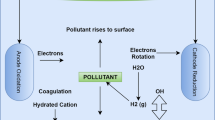Abstract
Coking wastewater was advanced treated by electrolytic experiment. Through the orthogonal method, we found out the optimum experimental condition as current density 20 mA/cm2, electrode plate span 1cm, electrolytic time 60 min, PH 7 and electrical conductivity 8000 μs/cm. The removal rates of COD, NH3-N and phenol were 58.62%, 89.9% and 96.8% respectively and the corresponding concentrations were 97.78mg/L, 14.3mg/L and 0.43mg/L respectively, which can meet first discharge standard of GB 13456-1992.
Access this chapter
Tax calculation will be finalised at checkout
Purchases are for personal use only
Preview
Unable to display preview. Download preview PDF.
Similar content being viewed by others
References
Cao, W.P., Xu, S.R., Chen, H.L.: Advanced Treatment of bio-treated coking effluent by Fenton Oxidation. J. Environmental Science & Technology 33, 305–308 (2010) (in Chinese)
Lai, P., Zhao, H.Z., Zeng, M.: Study on treatment of coking wastewater by biofilm reactors combined with zero-valent iron process. J. Hazardous. Materials 162, 1423–1429 (2009) (in Chinese)
Sag, Y., Kutsal, T.: The selective biosorption of chromium and copper(II)ions from binary metal mixtures by arrhizus. J. Process Biochemistry 31, 561–572 (1996)
Hosseini, S.H., Borghei, S.M.: The treatment of phenolic wastewater using a moving bed bio-reactor. J. Process Biochemistry 40, 1027–1031 (2005)
Lai, P., Zhao, H.Z., Wang, C.: Advanced treatment of coking wastewater by coagulation and zero-valent iron processes. J. Journal of Hazardous Materials 147, 1–2 (2007) (in Chinese)
Huang, Y., Huang, G., Lee, S.N.: Method of wastewater treatment by electrolysis and oxidization. P. US 6126838 (2000)
Yusuf , Yavuz., Savas, Koparal.: Electrochemical oxidation of phenol in a paralled plate reactor using ruthenium mixed metal oxide electrode. J. Hazardous Mater. B136, 296 (2006)
China SEPA.: The Water and Wastewater Monitoring Method (editor4). China Environ-mental Science Press, Beijing (2002) (in Chinese)
Hao, L.D., Yu, H.D.: On use of orthogonal experimental design. J. Actaeditologica. 17, 334–335 (2005) (in Chinese)
Takeshi, H., Kimihito, S., Taro, T., Tsutomu, S.: Coke powder heat-treated with boron oxide using an Acheson furnace for lithium battery anodes. J. Carbon. 40, 2317–2322 (2002)
Zhang, X., Wen, Y.B.: Advanced treatment of coking wastewater with electrocoagulation. J. Shanxi Architecture 35, 9 (2009) (in Chinese)
Zhu, X.P., Ni, J.R., Lai, P.: Advanced treatment of biologically pretreated coking waste-water by electrochemical oxidation using boron-doped diamond electrodes. J. Water Research 43, 4347–4355 (2009) (in Chinese)
Chen, W., Li, F.X., Mei, P.: Mechanism of COD Degradation in Wastewater Using Three Dimension Electrode Method. J. Environmental Science and Technology 25, 11–12 (2005) (in Chinese)
Liu, Y., Liu, D., Zhao, S.L.: Impact of chloride ion on undegradable landfill leachate treatment by electrochemical oxidation. J. Journal of Chongqing University. 31, 1431–1435 (2008) (in Chinese)
Author information
Authors and Affiliations
Editor information
Editors and Affiliations
Rights and permissions
Copyright information
© 2011 Springer-Verlag Berlin Heidelberg
About this paper
Cite this paper
He, X. et al. (2011). On the Best Condition of Electrolysis Coking Wastewater by Orthogonal Method. In: Lin, S., Huang, X. (eds) Advances in Computer Science, Environment, Ecoinformatics, and Education. CSEE 2011. Communications in Computer and Information Science, vol 215. Springer, Berlin, Heidelberg. https://doi.org/10.1007/978-3-642-23324-1_8
Download citation
DOI: https://doi.org/10.1007/978-3-642-23324-1_8
Publisher Name: Springer, Berlin, Heidelberg
Print ISBN: 978-3-642-23323-4
Online ISBN: 978-3-642-23324-1
eBook Packages: Computer ScienceComputer Science (R0)




